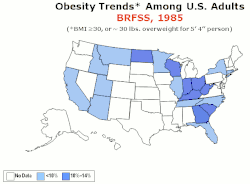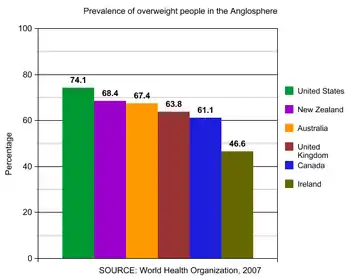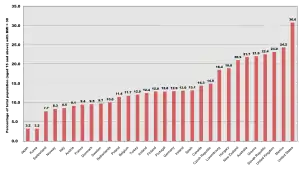Epidemiology of obesity
Obesity has been observed throughout human history. Many early depictions of the human form in art and sculpture appear obese.[3] However, it was not until the 20th century that obesity became common — so much so that, in 1997, the World Health Organization (WHO) formally recognized obesity as a global epidemic[4] and estimated that the worldwide prevalence of obesity has nearly tripled since 1975.[5] Obesity is defined as having a body mass index (BMI) greater than or equal to 30 kg/m2, and in June 2013 the American Medical Association classified it as a disease.[6]
| Part of a series on |
| Human body weight |
|---|


In countries of the Organisation for Economic Co-operation and Development (OECD), one child out of five is overweight or obese.[7] Once considered a problem only of high-income countries, obesity rates are rising worldwide. Globally, there are now more people who are obese than who are underweight, a trend observed in every region over the world except parts of sub-Saharan Africa and Asia.[8] In 2013, an estimated 2.1 billion adults were overweight, as compared with 857 million in 1980.[9] Of adults who are overweight, 31% are obese.[8] Increases in obesity have been seen most in urban settings.[10]
Since body fat can be measured in several ways, statistics on the epidemiology of obesity vary between sources. While BMI is the most basic and commonly used indicator of obesity, other measures include waist circumference, waist-to-hip ratio, skinfold thicknesses, and bioelectrical impedance.[11] The rate of obesity increases with age at least up to 50 or 60 years old.[12]
Africa
Obesity rates in Western Africa are estimated to be 10%. Rates of obesity among women are three times those found in men. In urban West Africa rates of obesity doubled between the 1990s and 2000s.[13]
Egypt
In Egypt, according to data from the 2016 Global Burden of Disease study, overweight and obesity (as measured by high BMI) was the country's leading risk factor driving the most death and disability combined.[14]
Asia
China
In the twenty first century, China faces challenges of obesity and chronic disease.[15] This is believed to be primarily due to the rapid declines in physical activity and changing dietary habits which have occurred between the 1980s and the 2000s. The decline in physical activity is attributed to increasing technology in the workplace and changing leisure activities.[15]
In 1989 65% of Chinese had jobs that required heavy labor. This decreased to 51% in the year 2000.[15] Combined with this has been a change to a diet higher in meat and oil,[15] and an increase in overall available calories.[16] Available calories per person increased from 2,330 kilocalories (9,700 kJ) per day in 1980 to 2,940 kilocalories (12,300 kJ) per day in 2002.[16] Rates of overweight and obese adults increased 12.9% in 1991 to 27.3% in 2004.[17]
Overall rates of obesity are below 5% in China as a whole but are greater than 20% in some cities.[18]
India
Obesity has reached epidemic proportions in India in the 21st century, with morbid obesity affecting 5% of the country's population.[19] Obesity is a major risk factor for cardiovascular disease and NGOs such as the Indian Heart Association have been raising awareness about this issue.[20] Urbanization and modernization has been associated with obesity.[21] In Northern India obesity was most prevalent in urban populations (male = 5.5%, female = 12.6%), followed by the urban slums (male = 1.9%, female = 7.2%). Obesity rates were the lowest in rural populations (male = 1.6%, female = 3.8%).[21]
Socioeconomic class also had an effect on the rate of obesity. Women of high socioeconomic class had rates of 10.4% as opposed to 0.9% in women of low socioeconomic class.[22] With people moving into urban centers and wealth increasing, concerns about an obesity epidemic in India are growing.
Iran
In Iran the prevalence of obesity was 26.3% in 2008. Prevalence of obesity was more among women (39.5%) than men (14.5%).[23]
Japan
Using the WHO criteria Japan has the lowest rate of obesity among the OECD member countries at 3.2%.[24][25] However, as Asian populations are particularly susceptible to the health risks of excess adipose tissue the Japanese have redefined obesity as any BMI greater than 25.[26] Using this cut off value the prevalence of obesity in Japan would be 20%, a threefold increase from 1962 to 2002.[27] A 2008 report stated that 28.6% of men and 20.6% of women in Japan were considered to be obese.[28]
Pakistan
Changing lifestyles, owing to urbanisation, as well as diet issues are the main reasons for obesity in Pakistan. According to a recent study, approximately one out of four Pakistani adults (or 22.2% of individuals) are classified as obese.[29][30]
Taiwan
In 2002, 15% of children from 6 to 12 years of age were overweight; by gender, 15.5% of males and 14.4% of females were overweight. In the same age range, 12% of children were obese; by gender, 14.7% of males and 9.1% of females were categorized as obese. In 2005, 14.9% children from 6 to 12 years of age were overweight; by gender, 15.85% of males and 14.02% of females were overweight. 10.3% were categorized as obese; by gender, 10.92% of males and 9.73% of females were categorized as obese.
Based on these numbers, the trends were inconclusive, although with more than 10% of the age group being obese, obesity does appear to be a problem.[31]
Europe
_1981-2006.jpg.webp)
Between the 1970s and the 2000s, rates of obesity in most European countries have increased. During the 1990s and 2000s, the 27 countries making up the EU reported rates of obesity from 10–27% in men and from 10–38% in women.[32]
The most recent combined Eurostat statistics, for 2009, show that, among the 19 EU Member States for which data are available, the proportion of obese people in the adult population varied in 2008/9 between 8.0% (Romania) and 23.9% (UK) for women and between 7.6% (Romania) and 24.7% (Malta) for men. Overall the UK had the highest proportions, and Romania the lowest. Men, the elderly and people with lower educations also have significantly higher obesity rates.[33]
North America
Epidemiological data show that, among high-income countries, obesity prevalence is highest in the United States and Mexico.[7]
Canada
The number of Canadians who are obese has risen dramatically in recent years. In 2004, direct measurements of height and weight found 23.1% of Canadians older than 18 had a BMI greater than 30. When broken down into degrees of obesity, 15.2% were class I (BMI 30–34.9), 5.1% were class II (BMI 35–39.9), and 2.7%, class III (BMI ≥ 40). This is in contrast to self-reported data the previous year of 15.2% and in 1978/1979 of 13.8%. The greatest increases occurred among the more severe degrees of obesity; class III obesity increased from 0.9% to 2.7% from 1978/1979 to 2004. Obesity in Canada varies by ethnicity; people of Aboriginal origin have a significantly higher rate of obesity (37.6%) than the national average.[34]
In children obesity has substantially increased between 1989 and 2004 with rates in boys increasing from 2% to 10% and rates among girls increasing from 2% to 9%.[35]
Mexico
Mexico has one of the highest rates of obesity among OECD countries, second only to the United States. To combat the epidemic, in 2014 Mexico implemented new taxes levied on food with excessive energy content and on sugar-sweetened beverages.[7]
United States


Obesity rates in the United States have nearly tripled since the 1960s. In 1962, about 13% of adult Americans were obese,[37] and by 2002, obesity rates reached 33% of the adult population.[38] According to the National Health and Nutrition Examination Study collected between the 1970s and 2004, the prevalence of overweight and obesity increased steadily among all groups of Americans.[39][40] The numbers continue to rise; as of 2007, 33% of men and 36% of women were obese,[41] and by 2015–2016, 39.6% of the total adult population (37.9% of men and 41.1% of women) had obesity.[42] As of 2017-2018, 42.4% of U.S. adults aged 20 and over were obese (43% for men and 41.9% for women).[43]
Obesity rates vary between diverse social groups, with some racial groups and low-income individuals more likely to be obese while other minorities show lower rates. As of 2014 the rates were as low as 12% for non-Hispanic Asian women and as high as 57% among African American women.[44][45]
The incidence of obesity also varies with geography. The American South has been referred to as the "Stroke belt", "Obesity belt", or "Diabetes belt", to reflect the fact that residents of the region have high rates of these three conditions, compared to people of the same race/ethnicity elsewhere in the country.[46]
Based on a study in 2008, estimates of obesity that rely on self-reported data arrive at a rate of 22% among non-Hispanic white females, whereas studies that involve direct measurement show that the rate was closer to 34% at that time.[47]
The prevalence of class III (morbid) obesity (BMI ≥ 40) has increased the most dramatically, from 1.3% in the late 1970s,[48] to 2.9% in 1988-94, to 4.7% in 2000,[49] to 5.7% in 2008, and to 7.7% in 2014.[50] Among African American women, its prevalence is estimated to be as high as 17%.[51]
The rate of increase in the incidence of obesity began to slow in the 2000s, but as of 2014, obesity, severe obesity, and obesity in children continued to rise.[41][52]

Obesity is one of the leading health issues in the United States, with some estimates suggesting that obesity results in about 300,000 excess deaths per year.[53] However, in 2005 using different methodology, research at the Centers for Disease Control and Prevention produced a nationwide estimate of 129,000 excess deaths per year relative to individuals with a BMI of 21 to 25.[54] In contrast, a 2013 review found that obesity was not associated with higher mortality than normal weight, and that overweight was associated with lower mortality than was normal weight.[55]
South America and the Caribbean
Surveys in different Caribbean countries found that 7-20% of males and 22-48% of females over the age of 15 are obese.[56] Trinidad and Tobago has the highest obesity in the Caribbean, with over 30% of its adult population overweight, ranking the country sixth in the world.[57] The Bahamas have a major obesity epidemic: 48.6% of people between 15 and 64 years old are obese.[58] A female adolescent from the Bahamas is more likely to be overweight than her male counterpart. In Jamaica, 7.2% of men over the age of 20 are obese, while 31.5% of women are obese.[59]
Oceania and the Pacific

Australia
According to self-reported and measured results of the 2007–2008 National Health Survey, 61% of Australians were overweight (above a 25 BMI), with 24% falling into the "obese" category (above a 30 BMI). Men were more likely to be overweight (67.7%) and obese (25.5%) than women (30.9% and 23.4% respectively).[61]
New Zealand
Obesity in New Zealand has become an important national health concern in recent years, with high numbers of people afflicted in every age and ethnic group.[62] In 2011/12, 28.4% of New Zealand adults were obese,[63] a number only surpassed in the English-speaking world by the United States.[60][62]
South Pacific
Many of the island nations of the South Pacific have very high rates of obesity. Nauru has the highest rates of obesity in the world (94.5%) followed by Samoa, the Federated States of Micronesia, and the American Samoa. Being big has traditionally been associated with health, beauty, and status and many of these beliefs remain prevalent today.[64]
See also
- Consumer Goods Forum
- Food industry
- Food politics
- Epidemiology of childhood obesity
- Epidemiology of metabolic syndrome
- Obesogen
- Overnutrition
- Sugar industry
- Ultra-processed food
- World Health Organization
References
- Roser, Max; Ritchie, Hannah (11 August 2017). "Obesity". Our World in Data. Retrieved 31 December 2017.
- "www.worldobesity.org" (PDF). Global prevalence of overweight and obesity. Archived from the original (PDF) on March 5, 2016. Retrieved Jan 8, 2016.
- Haslam D (March 2007). "Obesity: a medical history". Obes Rev. 8 Suppl 1: 31–6. doi:10.1111/j.1467-789X.2007.00314.x. PMID 17316298.
- Caballero B (2007). "The global epidemic of obesity: An overview". Epidemiol Rev. 29: 1–5. doi:10.1093/epirev/mxm012. PMID 17569676.
- "Obesity and overweight". World Health Organization.
- "Proceedings of the 2013 Annual Meeting of the House of Delegates".
- "OBESITY Update 2014, Retrieved 25 June 2014" (PDF).
- World Health Organization, Obesity and overweight. Fact sheet, updated June 2016. Geneva. Retrieved 22 Sept 2017.
- Ng, M.; Fleming, T.; Robinson, M.; Thomson, B.; Graetz, N.; Margono, C.; Mullany, E. C.; Biryukov, S.; Abbafati, C.; Abera, S. F.; Abraham, J. P.; Abu-Rmeileh, N. M. E.; Achoki, T.; Albuhairan, F. S.; Alemu, Z. A.; Alfonso, R.; Ali, M. K.; Ali, R.; Guzman, N. A.; Ammar, W.; Anwari, P.; Banerjee, A.; Barquera, S.; Basu, S.; Bennett, D. A.; Bhutta, Z.; Blore, J.; Cabral, N.; Nonato, I. C.; et al. (29 May 2014). "Global, regional, and national prevalence of overweight and obesity in children and adults during 1980–2013: A systematic analysis for the Global Burden of Disease Study 2013". The Lancet. 384 (9945): 766–781. doi:10.1016/S0140-6736(14)60460-8. ISSN 0140-6736. PMC 4624264. PMID 24880830.
- World Health Organization (2000). Technical report series 894: Obesity: Preventing and managing the global epidemic (PDF). Geneva: World Health Organization. ISBN 978-92-4-120894-9. Archived from the original (PDF) on May 26, 2006.
- Harvard T.H. Chan School of Public Health, Obesity Prevention Source. Boston. Retrieved 22 Sept 2017.
- Peter G. Kopelman; Ian D. Caterson; Michael J. Stock; William H. Dietz (2005). Clinical obesity in adults and children: In Adults and Children. Blackwell Publishing. p. 493. ISBN 978-1-4051-1672-5.
- Abubakari AR, Lauder W, Agyemang C, Jones M, Kirk A, Bhopal RS (July 2008). "Prevalence and time trends in obesity among adult West African populations: a meta-analysis". Obes Rev. 9 (4): 297–311. doi:10.1111/j.1467-789X.2007.00462.x. PMID 18179616. S2CID 4854424.
- Institute for Health Metrics and Evaluation, Global Burden of Disease Study 2016. Washington. Retrieved 22 Sept 2017.
- "The double burden of malnutrition Case studies from six developing countries". Food and Agricultural Organization of the UN. Retrieved January 11, 2009.
- "www.fao.org" (PDF). Food and Agricultural Organization of the UN. Archived from the original (PDF) on 2009-01-14.
- Popkin, Barry (August 22, 2007). "The World Is Fat". Scientific American. p. 94. ISSN 0036-8733. Retrieved 2008-07-24.
- "www.who.int" (PDF). WHO. Retrieved February 22, 2009.
- "India facing obesity epidemic: experts". The Hindu. 2007-10-12.
- Indian Heart Association Webpage 30 April 2015. <http://indianheartassociation.org/>
- Yadav K, Krishnan A (September 2008). "Changing patterns of diet, physical activity and obesity among urban, rural and slum populations in north India". Obes Rev. 9 (5): 400–8. doi:10.1111/j.1467-789X.2008.00505.x. PMID 18627500. S2CID 19081516.
- Praween Kumar Agrawal (2002-05-23). "Emerging obesity in northern Indian states: A serious threat for health" (PDF). IUSSP Conference, Bankik, 10 June–12-2002. Archived from the original (PDF) on 2012-02-09. Retrieved 2008-07-24.
- Rashidy-Pour A, Malek M, Eskandarian R, Ghorbani R (January 2009). "Obesity in the Iranian population". Obes Rev. 10 (1): 2–6. doi:10.1111/j.1467-789X.2008.00536.x. PMID 19021868. S2CID 38745827.
- Anon (2005). OECD Factbook: Economic, Environmental and Social Statistics. Organization for Economic Co-operation and Development. ISBN 978-92-64-01869-3.
- Harden, Blaine, "Japanese Women Buck Obesity Trend", The Washington Post, March 10, 2010.
- Anuurad E; Shiwaku K; Nogi A; et al. (November 2003). "The new BMI criteria for asians by the regional office for the western pacific region of WHO are suitable for screening of overweight to prevent metabolic syndrome in elder Japanese workers". J Occup Health. 45 (6): 335–43. doi:10.1539/joh.45.335. PMID 14676412.
- Kanazawa M, Yoshiike N, Osaka T, Numba Y, Zimmet P, Inoue S (December 2002). "Criteria and classification of obesity in Japan and Asia-Oceania". Asia Pac J Clin Nutr. 11 Suppl 8: S732–S737. doi:10.1046/j.1440-6047.11.s8.19.x. PMID 12534701.
- Fukue, Natsuko, "TV gets fickle fans flocking to fads to shed fat", Japan Times, March 9, 2010, p. 3.
- "One in four adults is overweight or clinically obese". Gulf News. December 17, 2006.
- Streib, Lauren (2 August 2007). "World's Fattest Countries". Forbes. Archived from the original on October 16, 2007.
- Committee for Health and Development Promotion for Children(兒童健康推展委員會) (April 4, 2007). "肥胖防治要從小紮根". Ministry of Health Promotion, Department of Health, Taiwan (R.O.C.).
- Tim Lobstein; Neville Rigby; Rachel Leach (2005-03-15). EU platform on diet, physical activity and health: International Obesity Task Force EU Platform Briefing Paper (PDF). International Obesity Task Force. Retrieved 2008-07-23.
- Eurostat – Statistics Explained: Overweight and obesity – BMI_statistics, see 'Source data for tables, figures and maps'
- Tjepkema M (2005-07-06). "Measured Obesity–Adult obesity in Canada: Measured height and weight". Nutrition: Findings from the Canadian Community Health Survey. Ottawa, Ontario: Statistics Canada. Archived from the original on 2008-10-12. Retrieved 2009-01-15.
- Lau DC, Douketis JD, Morrison KM, Hramiak IM, Sharma AM, Ur E (April 2007). "2006 Canadian clinical practice guidelines on the management and prevention of obesity in adults and children summary". CMAJ. 176 (8): S1–13. doi:10.1503/cmaj.061409. PMC 1839777. PMID 17420481.
- "Obesity and Overweight for Professionals: Data and Statistics: Adult Obesity Facts". Centers for Disease Control and Prevention. 2012-08-13. Archived from the original on 2009-08-25. Retrieved 2012-11-05.
- https://www.cdc.gov/nchs/data/hus/2010/071.pdf
- Ogden CL, Carroll MD, Curtin LR, McDowell MA, Tabak CJ, Flegal KM (2006). "Prevalence of overweight and obesity in the United States, 1999–2004". JAMA. 295 (13): 1549–55. doi:10.1001/jama.295.13.1549. PMID 16595758.
- National Institutes of Health (1998). "Clinical guidelines on the identification, evaluation, and treatment of overweight and obesity in adults: the evidence report" (PDF). Obesity Research. 6 (Suppl 2): 51S.
- Ogden, CL; Carroll, MD; Curtin, LR; McDowell, MA; Tabak, CJ; Flegal, KM (2006). "Prevalence of overweight and obesity in the United States, 1999–2004". JAMA. 295 (13): 1549–1555. doi:10.1001/jama.295.13.1549. PMID 16595758.
- Bessesen DH (June 2008). "Update on obesity". J. Clin. Endocrinol. Metab. 93 (6): 2027–34. doi:10.1210/jc.2008-0520. PMID 18539769.
- Hales, Craig M.; Carroll, Margaret D.; Fryar, Cheryl D.; Ogden, Cynthia L. (October 2017). "Prevalence of Obesity Among Adults and Youth: United States, 2015–2016". NCHS Data Brief (288): 1–8. ISSN 1941-4927. PMID 29155689.
- Hales CM, Carroll MD, Fryar CD, Ogden CL (2020). Prevalence of Obesity Among Adults and Youth: United States, 2017–2018 (PDF) (NCHS data brief, no. 360). Hyattsville, MD: National Center for Health Statistics. Retrieved 2020-11-19 – via www.cdc.gov.
- "International Obesity Task Force" (PDF). March 15, 2005. Retrieved 2008-09-19.
- Flegal, KM; Kruszon-Moran, D; Carroll, MD; Fryar, CD; Ogden, CL (7 June 2016). "Trends in Obesity Among Adults in the United States, 2005 to 2014". JAMA. 315 (21): 2284–91. doi:10.1001/jama.2016.6458. PMID 27272580.
- Healy, Melissa (2011-03-08). "Diabetes belt: American South gets more health notoriety". Los Angeles Times.
- "Prevalence of obesity among adults, by black/white race or Hispanic ethnicity, census region, and sex – Behavioral Risk Factor Surveillance System surveys, United States, 2006–2008".
- Finkelstein EA, Ruhm CJ, Kosa KM (2005). "Economic Causes and Consequences of Obesity". Annual Review of Public Health. 26 (1): 239–257. doi:10.1146/annurev.publhealth.26.021304.144628. ISSN 0163-7525. PMID 15760288.
- Flegal, KM; Carroll, MD; Ogden, CL; Johnson, CL (2002). "Prevalence and Trends in Obesity Among US Adults, 1999-2000". JAMA: The Journal of the American Medical Association. 288 (14): 1723–7. doi:10.1001/jama.288.14.1723. PMID 12365955.
- Flegal, KM; Kruszon-Moran, D; Carroll, MD; Fryar, CD; Ogden, CL (7 June 2016). "Trends in Obesity Among Adults in the United States, 2005 to 2014". JAMA. 315 (21): 2284–91. doi:10.1001/jama.2016.6458. PMID 27272580.
- Flegal, KM; Kruszon-Moran, D; Carroll, MD; Fryar, CD; Ogden, CL (7 June 2016). "Trends in Obesity Among Adults in the United States, 2005 to 2014". JAMA. 315 (21): 2284–91. doi:10.1001/jama.2016.6458. PMID 27272580.
- Flegal, KM; Kruszon-Moran, D; Carroll, MD; Fryar, CD; Ogden, CL (7 June 2016). "Trends in Obesity Among Adults in the United States, 2005 to 2014". JAMA. 315 (21): 2284–91. doi:10.1001/jama.2016.6458. PMID 27272580.
- Allison, DB; Fontaine, KR; Manson, JR.; Stevens, J; Vanitallie, TB (1999). "Annual deaths attributable to obesity in the United States". JAMA. 282 (16): 1530–8. doi:10.1001/jama.282.16.1530. PMID 10546692.
- Flegal Katherine M.; et al. (2005). "Excess Deaths Associated with Underweight, Overweight, and Obesity". Journal of the American Medical Association. 293 (15): 1861–67. doi:10.1001/jama.293.15.1861. PMID 15840860.
- Flegal KM, Kit BK, Orpana H, Graubard BI (January 2013). "Association of all-cause mortality with overweight and obesity using standard body mass index categories: a systematic review and meta-analysis". JAMA. 309 (1): 71–82. doi:10.1001/jama.2012.113905. PMC 4855514. PMID 23280227.
- "Archived copy" (PDF). Archived from the original (PDF) on 2016-03-04. Retrieved 2015-01-26.
{{cite web}}: CS1 maint: archived copy as title (link) - "Trinidad tops obesity list in the Caribbean". Archived from the original on 2020-05-07. Retrieved 2015-01-26.
- "The Bahamas." FAO – Nutrition Country Profiles. FOOD AND AGRICULTURE ORGANIZATION OF THE UNITED NATIONS, 1 Aug. 2003. Web. 26 Feb. 2015. <ftp://ftp.fao.org/ag/agn/nutrition/ncp/bhsmap.pdf%5B%5D>
- "FAO – NUTRITION COUNTRY PROFILES." Jamaica. FOOD AND AGRICULTURE ORGANIZATION OF THE UNITED NATIONS, 1 Aug. 2003. Web. 26 Jan. 2015. <http://www.fao.org/docrep/017/aq027e/aq027e.pdf>
- Lauren Streib (February 8, 2007). "World's Fattest Countries". Forbes. Archived from the original on October 16, 2007. Retrieved 2009-02-12.
- "Body section (Overweight and Obesity 2007–08)". Archived from the original (PDF) on 2016-09-03. Retrieved 2012-03-19.
- "Obesity – Social Report 2008". Ministry of Social Development. June 1, 2008. Retrieved 2009-07-05.
- Ministry of Health (2012). The Health of New Zealand Adults 2011/12. Wellington: Ministry of Health.
- "Obesity in the Pacific Too Big To Ignore" (PDF). Secretariat of the Pacific Community. WHO. 2002. Archived from the original (PDF) on 2014-09-11. Retrieved 2008-09-30.
External links
- World Health Organisation Global Database on Body Mass Index
- Ogden, Cynthia L.; et al. (2013). Prevalence of obesity among adults: United States, 2011–2012. Hyattsville, Md.: U.S. Department of Health and Human Services, Centers for Disease Control and Prevention, National Center for Health Statistics.
